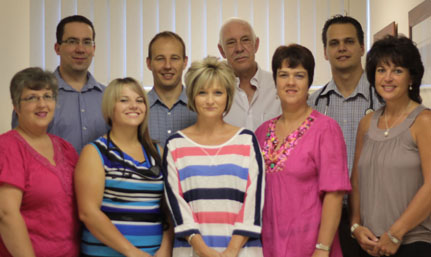 |
|
Front from the left, are: Marinda Karsten (study coordinator and registered nurse),
Laumarie de Wet (clinical technologist), Charmaine Krahenbuhl (study coordinator and radiographer),
Lorinda de Meyer (administrator), Andonia Page (study coordinator and enrolled nurse);
back Dr Gideon Visagie (sub investigator), Dr Derick Aucamp (sub investigagtor),
Prof. Hennie Theron, (principal investigator) and Dr Wilhelm Herbst (sub investigator).
Photo: Supplied
09 January 2013 |
The Cardiology Research Unit at the University of the Free State (UFS) contributed largely to the evaluation of the drug Juxtapid (lomitapide), which was developed by the Aegerion pharmaceutical company and approved by the FDA (Federal Drug Administration). Together with countries such as die USA, Canada and Italy, the UFS’ Unit recruited and evaluated the most patients (5 of 29) for the study since 2008.
The drug was evaluated in persons with so-called familial homozygous hypercholesterolemia (HoFH).
Following its approval by the FDA, Juxtapid is now a new treatment option for patients suffering from HoFH. The drug operates in a unique way which brings about dramatic improvements in cholesterol counts.
According to Prof. Hennie Theron, Associate Professor in the Department of Cardiology at the UFS and Head of the Cardiology Contract Research Unit, HoFH is a serious, rare genetic disease which affects the function of the receptor responsible for the removal of low-density lipoprotein cholesterol (LDL-C) (“bad” cholesterol) from the body. Damage to the LDL receptor function leads to extremely high levels of blood cholesterol. HoFH patients often develop premature and progressive atherosclerosis, which is a narrowing or blockage of the arteries.
“HoFH is a genetically transmitted disease and the most severe form of hypercholesterolemia. Patients often need a coronary artery bypass or/and aortic valve replacement before the age of 20. Mortality is extremely high and death often occurs before the third decade of life. Existing conventional cholesterol-lowering medication is unsuccessful in achieving normal target cholesterol values in this group of patients.
“The only modality for treatment is plasmapheresis (similar to dialysis in patients with renal failure). Even with this type of therapy the results are relatively unsatisfactory because it is very expensive and the plasmapheresis has to be performed on a regular basis.
“The drug Juxtapid, as currently evaluated, has led to a dramatic reduction in cholesterol values and normal values were achieved in several people. No existing drug is nearly as effective.
“The drug represents a breakthrough in the treatment of familial homozygous hypercholesterolemia. The fact that it has been approved by the FDA, gives further impetus to the findings,” says Prof. Theron.
In future further evaluation will be performed in other forms of hypocholesterolemia.
According to Prof. Theron, the findings of the study, as well as the recent successful FDA evaluation, once again confirms the fact that the UFS’ Cardiology Contract Research Unit is doing outstanding work.
Since its inception in 1992, the Unit has already been involved in more than 60 multi-centre, international phase 2 and 3 drug studies. Several of these studies, including the abovementioned study, really affected the way in which cardiology functions.
The UFS’ Cardiology Contract Research Unit is being recognised nationally and internationally for its high quality of work and is constantly approached for their involvement in new studies.